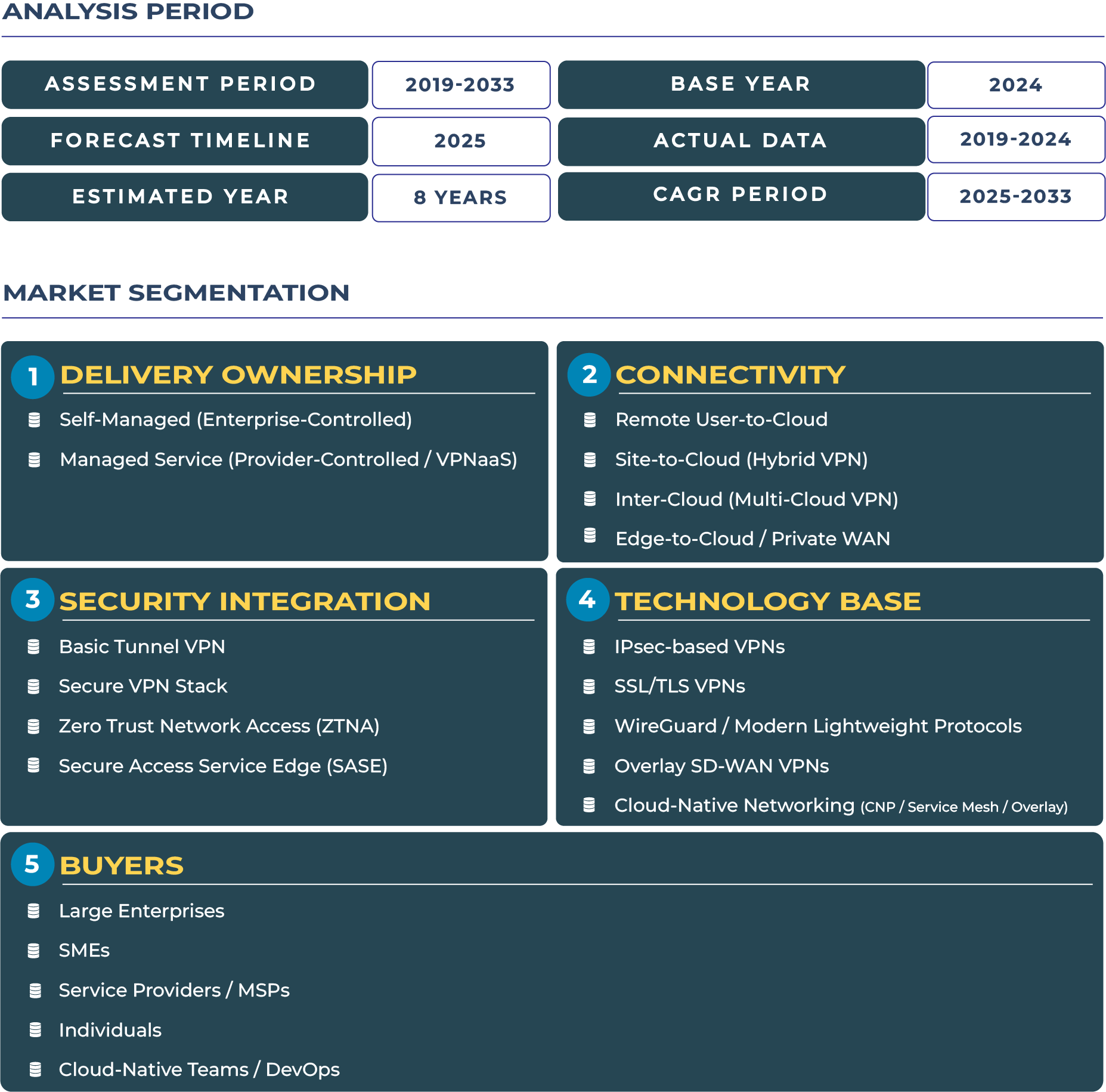Report Format:
![]()
![]() |
Pages: 160+
|
Pages: 160+
North America Cloud VPN Market Outlook: Navigating the Future of Secure Enterprise Connectivity in North America
The North American Cloud Virtual Private Networks (Cloud VPN) market stands at a pivotal juncture in 2025, with an estimated valuation of USD 6.5 billion. Projections indicate a robust growth trajectory, reaching approximately USD 23 billion by 2033, reflecting a compound annual growth rate (CAGR) of 17.1% from 2025 to 2033. This expansion is propelled by the region's leadership in digital transformation, characterized by widespread enterprise adoption of Secure Access Service Edge (SASE) architectures and Zero Trust Network Access (ZTNA) frameworks. These advancements are reshaping the traditional VPN landscape, emphasizing the need for scalable, secure, and agile connectivity solutions that align with modern enterprise requirements.
Drivers & Restraints: Forces Shaping the Cloud VPN Landscape
Accelerated Cloud and SaaS Adoption Fueling Market Expansion
The surge in cloud and Software-as-a-Service (SaaS) adoption across enterprises is a primary catalyst for the growth of the Cloud VPN market in North America. Organizations are increasingly migrating to cloud-based infrastructures to enhance operational efficiency and scalability. This shift necessitates robust and secure connectivity solutions to ensure seamless access to cloud resources. Managed Service Providers (MSPs) play a pivotal role in this ecosystem, offering tailored VPN-as-a-Service (VPNaaS) solutions that cater to the diverse needs of enterprises, from small businesses to large corporations.
Challenges in Vendor Consolidation and Regional Procurement Fragmentation
Despite the market growth, challenges persist. The consolidation among VPN vendors has led to reduced pricing strategies, potentially impacting service quality and innovation. Additionally, the fragmentation of procurement processes across various states and regions introduces complexities in standardizing and managing VPN solutions. These factors necessitate a strategic approach to vendor selection and procurement processes to maintain service integrity and compliance across the enterprise landscape.
Trends & Opportunities: Shaping the Future of Cloud VPN Solutions
Shift Towards SASE and ZTNA Architectures
A significant trend influencing the North America Cloud VPN market is the transition towards SASE and ZTNA architectures. These frameworks integrate networking and security services into a unified cloud-delivered model, providing enterprises with enhanced security posture and simplified network management. The adoption of WireGuard and TLS-based tunnels is also gaining momentum due to their performance advantages over traditional protocols, facilitating more efficient and secure remote access solutions.
Opportunities in Bundled Security Services and Edge Computing
Enterprises are increasingly seeking comprehensive solutions that combine VPN services with additional security features such as Firewall-as-a-Service (FWaaS) and Cloud Access Security Brokers (CASB). Bundling these services offers enhanced security coverage and simplifies management for organizations. Furthermore, the deployment of edge Points of Presence (PoPs) is becoming crucial for latency-sensitive applications, ensuring optimal performance and user experience across geographically distributed networks.
Regional Analysis: Country-Specific Insights
-
United States
The U.S. remains a dominant force in the Cloud VPN market, driven by its robust technological infrastructure and high enterprise cloud adoption rates. The integration of SASE and ZTNA models is prevalent among large enterprises seeking to enhance security and operational efficiency.
-
Canada
Canada Cloud VPN market is characterized by a strong emphasis on data sovereignty and compliance with stringent regulatory frameworks. Enterprises in Canada are increasingly adopting cloud-native VPN solutions to meet these requirements while ensuring secure connectivity.
-
Mexico
Mexico cloud VPN market is experiencing growth as small and medium-sized enterprises (SMEs) embrace cloud technologies. The demand for cost-effective and scalable VPN solutions is rising, presenting opportunities for MSPs to offer tailored VPNaaS solutions to this segment.
Competitive Landscape: Key Players and Strategic Developments
The competitive landscape of the North American Cloud VPN market is marked by the presence of both established and emerging players. Companies are focusing on enhancing their service offerings through strategic partnerships, technological advancements, and market expansions.
- Cloudflare has been proactive in enhancing its network capabilities, as evidenced by its recent announcement of a global network upgrade with new Magic Transit and Access enhancements. This initiative aims to bolster Cloudflare's Access capabilities and backbone performance, aligning with the growing demand for secure and efficient cloud connectivity solutions.
- Akamai continues to innovate in the realm of edge security, with recent enhancements to its enterprise application access solutions. These upgrades focus on improving cloud edge security features, positioning Akamai as a formidable player in the Cloud VPN market.
- Cato Networks has expanded its presence in North America by releasing a next-generation SASE gateway with an expanded Points of Presence (PoP) footprint. This expansion aims to improve global low-latency SASE and VPN performance, catering to the increasing demand for secure and high-performance connectivity solutions.
Conclusion: Navigating the Evolving Cloud VPN Ecosystem
The North American Cloud VPN market is undergoing a significant transformation, driven by the convergence of cloud adoption, security frameworks like SASE and ZTNA, and the demand for scalable connectivity solutions. Enterprises are increasingly seeking integrated solutions that offer enhanced security, performance, and compliance. As the market continues to evolve, stakeholders must stay attuned to technological advancements, regulatory changes, and emerging market dynamics to capitalize on growth opportunities and navigate challenges effectively.








